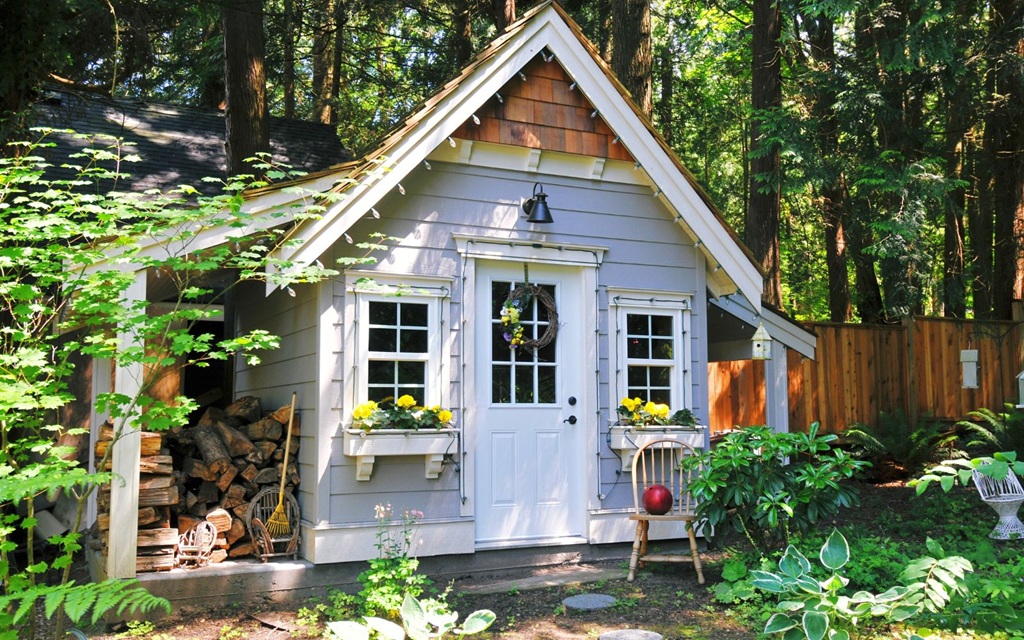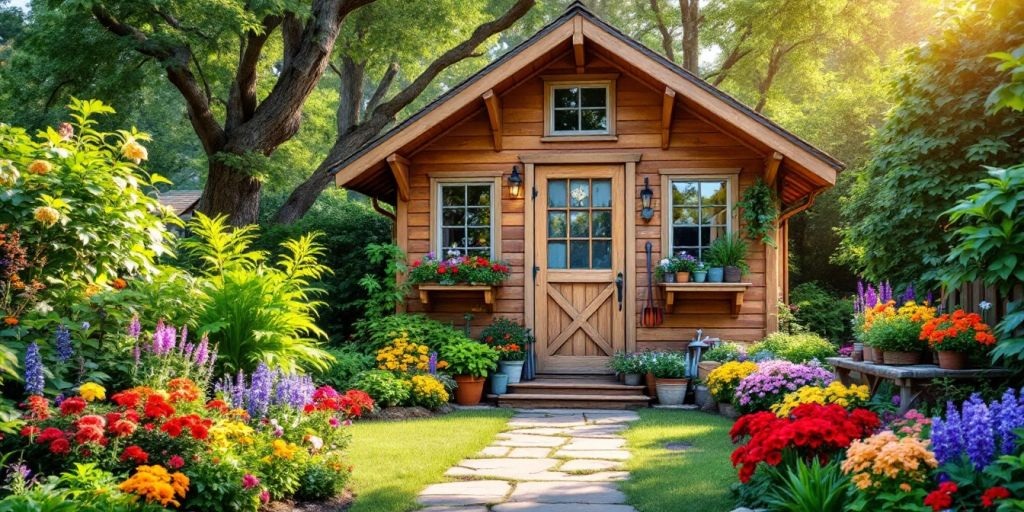A garden shed is more than just a place to store tools; it’s an extension of your home, a sanctuary where you can indulge in hobbies, potter with plants, or simply escape the everyday hustle. But with a dizzying array of options available, finding the perfect shed can feel overwhelming. Fear not! This comprehensive guide will walk you through everything you need to consider, from size and materials to planning permission and those all-important finishing touches.
-
Size Matters: Finding the Right Fit for Your Needs
Before you get swept away by charming designs and fancy features, take a hard look at your available space and storage needs. Measure the area where you envision your shed, keeping in mind access points and any existing structures or plants.
Next, consider what you’ll be storing. Will it be just a few gardening tools, or do you need space for bulky equipment like lawnmowers, bicycles, and seasonal decorations? Think about your hobbies too. Do you dream of a potting bench, a workshop area, or even a cozy reading nook?
Pro Tip: It’s always better to err on the side of slightly larger than you think you need. You’ll thank yourself later!
-
Material World: Exploring Shed Construction Options
Garden sheds come in a variety of materials, each with its own pros and cons in terms of durability, maintenance, and aesthetics:
- Wood: The classic choice, wood offers natural beauty and blends seamlessly into any garden setting. It’s also relatively easy to customize and repair. However, wood requires regular treatment to protect it from the elements and prevent rot and insect damage. Popular wood options include cedar, redwood, and pressure-treated pine.
- Metal: Metal sheds are durable, low-maintenance, and resistant to fire, rot, and pests. They are often more affordable than wood but can be prone to rust and dents. Look for sheds with galvanized steel or aluminum construction for enhanced weather resistance.
- Plastic: Lightweight and virtually maintenance-free, plastic sheds are a budget-friendly option. They resist rot and insects but can become brittle and fade in sunlight over time. Consider reinforced plastic models for increased strength and durability.
- Vinyl: Vinyl sheds offer similar benefits to plastic but are generally more durable and fade-resistant. They are also easy to clean and require minimal upkeep. However, vinyl sheds can be more expensive than plastic or metal options.
-
Style Counsel: Choosing a Shed that Complements Your Home
Your garden shed should be an attractive addition to your outdoor space, not an eyesore. Consider your home’s architectural style and the overall aesthetic of your garden.
- Traditional: Classic gable or apex roof sheds with wooden cladding and charming details like window boxes and decorative trim.
- Modern: Clean lines, minimalist design, and contemporary materials like metal or composite panels. Flat roofs or sleek pent roofs are popular choices.
- Cottage: Quaint and charming, with features like arched windows, flower boxes, and pastel color palettes.
- Cabin: Rustic and cozy, with log cabin-style walls, exposed beams, and a natural wood finish.
Pro Tip: Don’t forget about the roof! Choose a roofing material that complements your home and offers adequate weather protection. Popular options include asphalt shingles, metal roofing, and cedar shingles.
-
Foundation Fundamentals: Ensuring Stability and Longevity
A solid foundation is crucial for any shed, providing stability and preventing moisture damage. Common foundation options include:
- Concrete Slab: A level concrete slab offers the most stable and durable base for your shed. It also helps to prevent rodents and insects from entering.
- Gravel Pad: A more affordable option, a gravel pad provides good drainage and can be relatively easy to install. However, it may require occasional leveling and weed control.
- Pressure-Treated Timber Base: This involves constructing a frame from pressure-treated lumber, which is then supported by concrete blocks or piers. It offers good ventilation and can be adapted to uneven ground.
- Paving Slabs: A simple and cost-effective solution for smaller sheds, paving slabs provide a level surface and can be easily replaced if damaged.
Pro Tip: Always ensure your chosen foundation is level and adequately sized to support the weight of your shed.
-
Windows and Doors: Letting in Light and Air
Windows and doors play a crucial role in your shed’s functionality and aesthetics. Consider the following:
- Natural Light: Ample natural light makes your shed more inviting and functional. Opt for windows that maximize sunlight while minimizing glare. Consider skylights for overhead illumination.
- Ventilation: Good ventilation is essential to prevent moisture buildup and keep your shed fresh. Choose windows that open and consider installing vents or a roof vent.
- Security: Solid doors with secure locks are essential to protect your valuable tools and equipment. Consider reinforced doors and windows for added security.
- Style: Choose window and door styles that complement your shed’s overall design and enhance its curb appeal.
-
Planning Permission: Navigating Local Regulations
Before you erect your dream shed, it’s essential to check if you need planning permission. Regulations vary depending on your location, the size of your shed, and its intended use.
Generally, smaller sheds (under a certain size) and those located at the rear of your property may not require planning permission. However, larger sheds, those positioned close to boundaries, or those intended for habitable use (like a home office or guest room) may require approval.
Pro Tip: Contact your local planning authority for specific guidelines and regulations in your area. It’s always better to be safe than sorry!
-
Assembly Required: DIY vs. Professional Installation
Garden sheds are typically available as DIY kits or can be professionally installed. Consider your budget, DIY skills, and available time when making this decision.
- DIY Kits: DIY kits are generally more affordable and offer a sense of accomplishment. However, they require time, tools, and some construction know-how. Ensure you have the necessary skills and assistance before embarking on a DIY project.
- Professional Installation: Professional installation offers convenience and peace of mind, ensuring your shed is assembled correctly and securely. However, it comes at an additional cost. Choose a reputable installer with experience in shed construction.
-
Finishing Touches: Personalizing Your Shed
Once your shed is built, it’s time for the fun part – adding those personal touches that transform it into your own backyard haven.
- Painting and Decorating: Choose colors and finishes that complement your garden and reflect your personal style. Consider adding decorative elements like window boxes, shutters, and trellises.
- Interior Organization: Maximize your shed’s storage potential with shelves, hooks, drawers, and tool racks. Create dedicated zones for different activities like gardening, potting, or DIY projects.
- Lighting and Electrical: Install adequate lighting for evening use and consider adding electrical outlets for power tools and other equipment.
- Comfort and Ambiance: Add personal touches like comfortable seating, cushions, rugs, and artwork to create a welcoming and inviting space.
Related: Windowsill Gardening in Winter: Cultivating a Lush Indoor Oasis
Top-Rated Garden Sheds: Reviews and Recommendations

To help you in your search, we’ve compiled a list of some top-rated garden sheds across different categories:
Best Overall:
- Lifetime 6446 Outdoor Storage Shed: This durable and spacious shed is made from high-density polyethylene and features steel reinforcements for added strength. It offers excellent weather resistance, low maintenance, and a 10-year warranty.
Best Wooden Shed:
- YardCraft Somerset Shed: This beautifully crafted wooden shed boasts classic styling, ample storage space, and high-quality materials. It features cedar siding, a sturdy floor, and attractive architectural details.
Best Metal Shed:
- Arrow Newport Shed: This galvanized steel shed offers excellent durability and weather resistance at an affordable price. It features a tall walk-in design, lockable doors, and a 10-year warranty.
Best Budget Shed:
- Suncast BMS3400 Shed: This compact and affordable plastic shed is perfect for storing essential gardening tools and equipment. It’s easy to assemble, low maintenance and features a lockable door for added security.
Best Modern Shed:
- Studio Shed Signature Series: This contemporary shed offers a sleek design and customizable options to create a personalized backyard studio, home office, or guest room. It features high-quality materials, energy-efficient construction, and modern amenities.
Pro Tip: Read online reviews and compare features before making your final decision. Consider your specific needs, budget, and aesthetic preferences.
Frequently Asked Questions (FAQ)
-
Do I need a permit to build a garden shed?
As mentioned earlier, permit requirements vary depending on your location and the shed’s size and intended use. Contact your local planning authority for specific guidelines.
-
What is the best material for a garden shed?
The best material depends on your budget, aesthetic preferences, and maintenance requirements. Wood offers natural beauty but requires regular upkeep. Metal is durable and low-maintenance but can be prone to rust. Plastic and vinyl are affordable and easy to care for but may not be as durable as wood or metal.
-
How do I prevent my shed from rotting?
Ensure your shed has a solid foundation and adequate ventilation. Regularly treat wooden sheds with a wood preservative and sealant to protect them from moisture and insects.
-
How can I make my shed more secure?
Install strong locks on all doors and windows. Consider adding security features like reinforced doors, window bars, and a shed alarm.
-
Can I use my shed as a home office or living space?
Yes, but you may need planning permission and will need to ensure it meets building regulations for habitable use. This may include insulation, electrical wiring, and adequate ventilation.
-
How do I maintain my garden shed?
Regular maintenance will prolong the life of your shed. This includes cleaning gutters, checking for leaks, treating wood, and repainting or staining as needed.
Conclusion:
Choosing the right garden shed involves careful consideration of various factors, from size and materials to style and functionality. By following this comprehensive guide and exploring the top-rated options, you can find the perfect shed to enhance your outdoor space and provide years of enjoyment. Remember to prioritize your needs, budget, and personal preferences to create a backyard haven that truly reflects your unique style.




